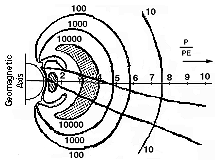 Cross-section of the two radiation belts, together with the orbits of Pioneers 3 and 4 which contributed early observations of them.
| The outer radiation belt is nowadays seen as part of the plasma trapped in the magnetosphere. The name "radiation belt" is usually applied to the more energetic part of that plasma population, e.g. ions of about 1 Mev of energy (see energy units). The more numerous lower-energy particles are known as the "ring current", since they carry the current responsible for magnetic storms. Most of the ring current energy resides in the ions (typically, with 0.05 MeV) but energetic electrons can also be found.
|
 Official GSFC Home Page
Official GSFC Home Page  NASA WWW Home Page
NASA WWW Home Page